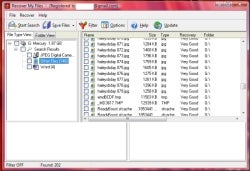The fact that reformatting a hard drive doesn’t completely erase the data stored on it is both a blessing and a curse depending on your circumstances. For example, if you reformat your hard drive prior to upgrading your PC’s operating system, only to realize you neglected to back up a critical folder, you’ll be relieved to know you stand a good shot at recovering that folder.
If, however, you buy a new PC and donate your old one to a charity, you might be donating company and client financial records or other sensitive data right along with it – even though you reformatted the drive.
A little information can help both recover critical data and prevent it from ending up in the wrong hands. We’ll take a look at ways to recover data from a reformatted drive and then at how to properly prepare a PC for donation.
Retrieving Deleted Files
I first discovered just how well data recovery software works when one of my clients bought a new PC and paid to have the old hard drive backed up by a local computer service provider. Once he started using the new system it didn’t take long to realize that an entire folder with years of digital images failed to make it to the new drive. The old hard drive had already been formatted and a clean copy of Windows XP install had already been installed on it. The search began to find out how to obtain the data that was hidden on that drive.
 The wizard within RecoverMyFiles lets you choose the type of file search you want. (Click for larger image). |
Fortunately, a variety of data recovery services can help you to retrieve deleted data from hard drives, including drives that have already been formatted. While the whole process sounds like nightmare for the technically uncertain, let me tell you, it is easy to do. If you can install software and perform basic tasks on your computer, then you can use data-retrieval software or services.
Ready to Donate: Scrub Your Hard Drive
White Canyon, makers of WipeDrive, a software utility that can completely erase a hard drive, caution that getting rid of an old computer without properly cleaning the hard drive can expose your personal information to others. Businesses unknowingly give away sensitive information when they donate their old systems.
The only secure way to permanently remove data from your old hard drive is to use a process called disk wiping or disk scrubbing. Disk wiping programs such as WipeDrive work by writing a character or series of characters across the entire hard drive, usually multiple times. Once the process is completed you’ll find it all but impossible to retrieve the data that was on the drive prior to wiping.
There is some industry debate as to how many times a drive needs to be rewritten in order for the old data to be one hundred percent irretrievable. But Henley, who worked eleven years in law enforcement as a Computer Forensics examiner says he has never encountered an instance where one complete cycle of character writes didn’t work.
Nathan Jones, director of sales for White Canyon agrees and says that the Department of Defense standard for sensitive data is three complete passes and a verification check. However, he notes, after a single pass on today’s modern hard drives, you would need an electronic microscope to see the data, and that no software could retrieve it. He believes the misconceptions regarding the number of passes needed to completely wipe the drive stem from information that was written with older hard drive technology in mind.
You can use the $39.99 version of WipeDrive for a total of twenty times. The $99 version, WipeDrive Pro, performs the disk wipe faster than the standard WipeDrive, and there are no limits to how many times, or on how many computers, you can use it.
If you used WipeDrive’s single-pass method on a 120 GB hard drive, it would take two hours to wipe, while WipeDrive Pro would wipe the drive in approximately 20 minutes; and using the three-pass standard it would complete the wipe in two hours.
Cleaning Supplies
Here are a few affordable products, both stand-alone and managed services, that can help small businesses recover erased data and completely clean an old office computer before it’s donated or recycled.
- R-Studio Data Recovery
- R-Undelete File Recovery
- StompSoft’s RecoverLost Data
- StompSoft’s DriveWasher
- Active @ Kill Disk
- WinUndelete
Some online data-retrieval services let you download and run their recovery program on a free-trial basis. It scans the hard and provides a report on all the files, folders, programs, etc. that still remain on the hard drive. If the results show that your much-needed files can indeed be retrieved, then you continue, and the service charges you a certain amount per megabyte or gigabyte of data recovered.
Jones says that he always recommends that people wipe the system first to ensure all sensitive data is irrecoverable, and then donate the system along with the install disks – instead of setting up the system yourself after the wipe process.
“This saves you time from reinstalling the operating system, and as an added benefit, if you donate the cleaned system with the install disks, your business is able to take a full tax deduction for the donation.”
Based in Nova Scotia, Canada, Vangie Beal has been writing about computers, games and technology since the early 90s. She’s also the managing editor of Webopedia.
| Do you have a comment or question about this article or other small business topics in general? Speak out in the SmallBusinessComputing.com Forums. Join the discussion today! |


